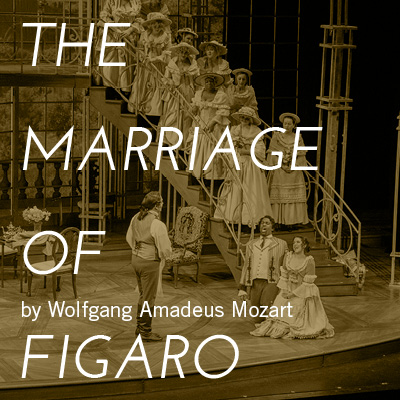Mozart’s Le Nozze di Figaro
Premier, Vienna, 1 May 1786

The Marriage of Figaro is opera’s longest running hit. Since opening 232 years ago at the Vienna Burgtheater, it has never required reviving. Even the efforts of Salieri, Righini, and Martini—infamous intriguers of Emperor Joseph’s Court—could not blunt Figaro’s success. Viennese audiences saw nine performances that season and their enthusiasm resulting in repeated calls for aria encores. In his memoirs, Michael Kelly, the Anglo-Irishman who sang the roles of Basilio and Don Curzio, tells us: “almost every scene was encored, which prolonged it nearly to the length of two operas, and induced the Emperor to issue an order, on the second presentation, that no piece of music should be encored.” The order was politely ignored.
Figaro’s appearance in Prague (the Austrian Empire’s other ‘capital’) was even more successful. In his letters home, Mozart reported: “Here they talk about nothing but ‘Figaro’. Nothing is played, sung or whistled but ‘Figaro.’ No opera is drawing like ‘Figaro.’ Nothing, nothing but ‘Figaro.’” So complete was Mozart’s success, it led immediately to the Don Giovanni commission, a marvelous consequence, indeed.

For Figaro, Mozart turned to Pierre Augustin Caron de Beaumarchais’ play, Le mariage de Figaro (1778), the second part of his stage trilogy that included Le barbiere de SéviIIe, and La Mère coupable (The Guilty Wife). Mozart was sufficiently impressed with the play (which he must have read, since its performance was banned in Vienna) to risk both censorship and the Emperor’s displeasure. Selecting Lorenzo Da Ponte to write the libretto, Mozart for once showed a little political savvy since Da Ponte was able to persuade Emperor Joseph the play was not revolutionary by deleting its political speeches. In his delightful, self-aggrandizing memoir, Da Ponte takes full credit for sanitizing Figaro by “expunging those incendiary passages.”
As a consequence, in the opera Figaro does not upbraid the Count by reminding him that an accident of his birth is his sole claim to fame: “Because you are a great noble you believe you are a great genius. Nobility, fortune, rank, position, what have you done to deserve all these goods? You went to the trouble of being born—nothing more!” In the late 18th century this was strong stuff, and in France Beaumarchais paid for it with a stint in the Saint-Lazare jail. But in Vienna, Da Pointe was aware of the Emperor’s feelings of contempt for hypocritical aristocrats, as well as for those untitled “royals” who all owed their wealth and eminence to the accident of birth.
Thus, for the libretto, Da Ponte dropped the provocative political speeches but changed little else in plot and structure. His creative energies went into inventing arias where only a line or two of dialogue exists in the play. And this genius for dramatic revelation inspired Mozart’s incredible music. And what music it is: so rich and varied as to be positively breathtaking. Yet, its beauty is always employed in delineating character and heightening the drama. In Mozart’s adaptation, Beaumarchais’ glib, sometimes superficial characters are transformed into complex ones, especially the three principals: Figaro, Susanna, and the Countess.
After The Marriage of Figaro’s sensational Vienna opening run, popular though it was with the general public, it became Mozart’s undoing at Court. Viennese aristocrats, as well as those untitled members of the upper class, were accustomed to seeing themselves glorified in opera. Indeed, Mozart’s two preceding works—Idomeneo (1781) and The Abduction from the Seraglio (1782)—conventionally glorified their aristocratic characters, portraying them as both generous and noble, while their servants are properly respectful and faithful. But after the ‘insult’ of Figaro, Mozart lost the precious little patronage he enjoyed for subscription concerts and new work commissions. Viennese ‘royals’ were not amused that Count Almaviva, the opera’s only representative of the privileged class, was so completely put down by his wife, in league with mere servants. They found nothing comic about this; rather, they found Mozart and his opera insolent.
The Mozart-Da Ponte collaboration produced two more opera—Don Giovanni (1787) and Così fan tutte (1790)—both of which enjoyed more favor with Prague audiences than with Viennese. And only in Don Giovanni did the libretto center on the affairs of an aristocrat, this one a famously reckless, even cruel, womanizer. But much of the class sting was glossed over by the fact that the Don Juan legend had its own mythical history. Taken together, all the Mozart-Da Ponte operas set a standard for music and story that has never been surpassed.

On this special occasion, it is well to remember that The Marriage of Figaro was the calling-card production for the Opera Association of Western Michigan (as Opera Grand Rapids was then known) in 1968, when locally produced opera began in Grand Rapids. It was an ambitious undertaking, one that has proved the local group was up to the challenge. And for the next 50 years that challenge has been repeatedly met with ever-increasing standards of excellence. It is therefore especially fitting we celebrate this 50th anniversary of Opera Grand Rapids with this new production of Mozart’s masterpiece.
by Gilbert R. Davis
Dr. Davis, GVSU Emeritus Professor of English, has been writing Opera Grand Rapids program notes since the 1970s, and with this one bids a fond addio.
May 4 & 5 | 7:30 PM | DeVos Performance Hall
OPERA | CLASSIC | COMEDY | ITALIAN
The quintessential comic opera.

